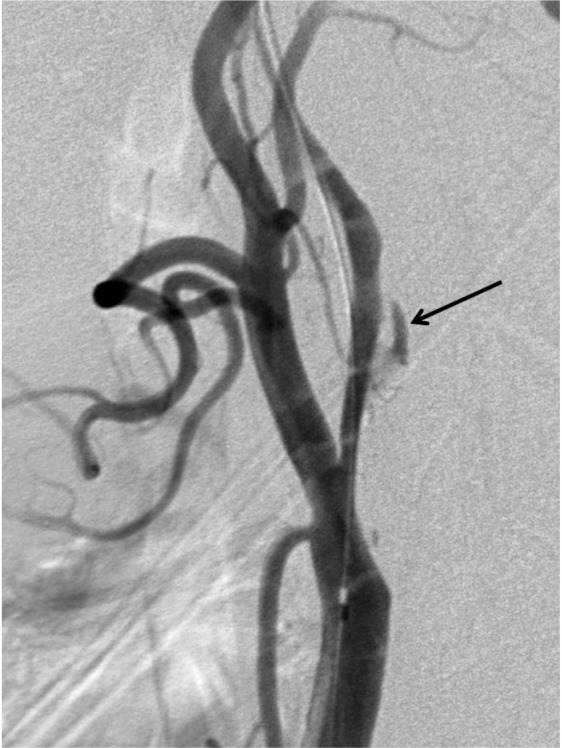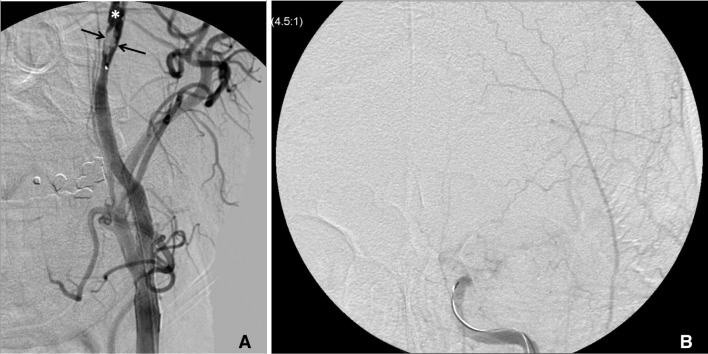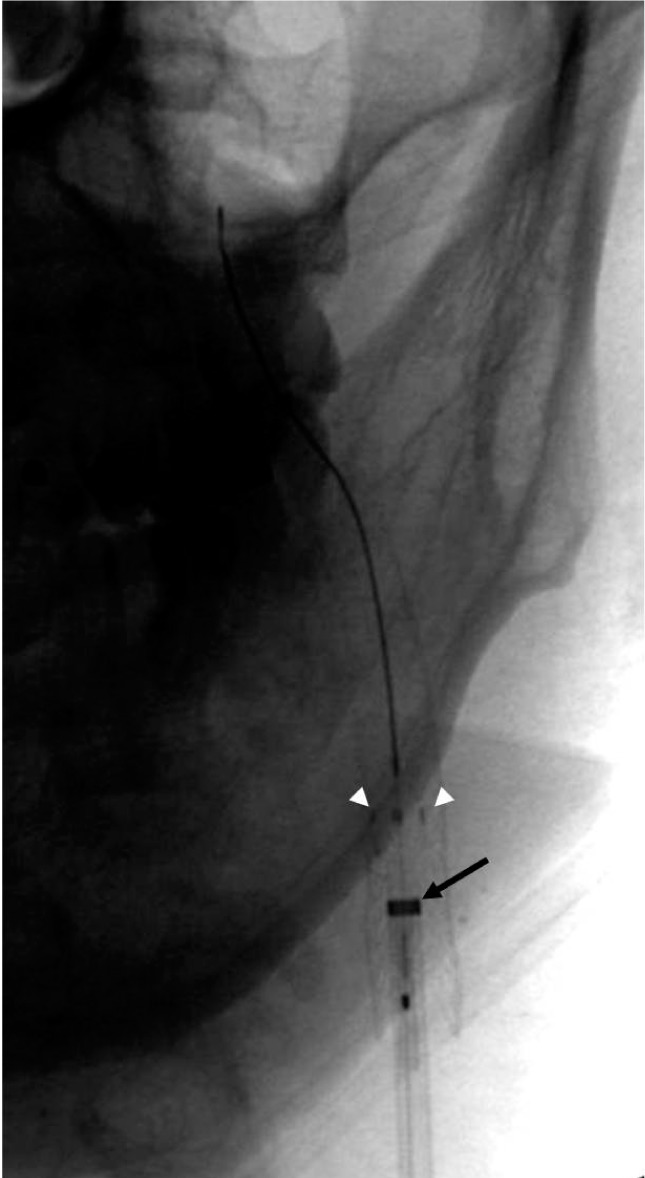Neurointervention.
2013 Feb;8(1):52-57. 10.5469/neuroint.2013.8.1.52.
Captured Macro-embolus of Fractured Atheromatous Plaque by the Embolic Protection Device during Carotid Stent Assisted Angioplasty
- Affiliations
-
- 1Department of Radiology, The University of Chicago, Chicago, IL, USA. sklee@uchicago.edu
- 2Department of Neurosurgery, Pohang Stroke and Spine Hospital, Pohang, Korea.
- 3Department of Medical Imaging, Toronto Western Hospital, Toronto, ON, Canada.
- 4Department of Pathology, Toronto Western Hospital, Toronto, ON, Canada.
- KMID: 2052082
- DOI: http://doi.org/10.5469/neuroint.2013.8.1.52
Abstract
- The authors present a case in which macro-embolus from the ruptured atheromatous plaque developed during carotid artery stenting (CAS). A 63-year-old man who had suffered a left middle cerebral artery territory infarction had significant proximal left internal carotid artery stenosis required CAS procedure. Immediate after stent deployment, the patient showed abrupt neurological deterioration with 12 x 3 mm sized macro-embolus which was caught by the embolus protection device (EPD). Retrieval of the macro-embolus was performed safely and the patient recovered to pre-procedure status. Macro-embolus can be resulted during the CAS. The EPD can capture the macro-embolus and safe removal is technically feasible.
MeSH Terms
Figure
Reference
-
1. Angelini A, Reimers B, Barbera MD, Sacca S, Pasquetto G, Cernetti C, et al. Cerebral protection during carotid artery stenting: collection and histopathologic analysis of embolized debris. Stroke. 2002; 33:456–461. PMID: 11823652.2. Whitlow PL, Lylyk P, Londero H, Mendiz OA, Mathias K, Jaeger H, et al. Carotid artery stenting protected with an emboli containment system. Stroke. 2002; 33:1308–1314. PMID: 11988608.
Article3. Gray WA, Hopkins LN, Yadav S, Davis T, Wholey M, Atkinson R, et al. the ARCHeR Trial Collaborators. Protected carotid stenting in high-surgical-risk patients: the ARCHeR results. J Vasc Surg. 2006; 44:258–269. PMID: 16890850.
Article4. Hill MD, Morrish W, Soulez G, Nevelsteen A, Maleux G, Rogers C, et al. the MAVErIC International Investigators. Multicenter evaluation of a self-expanding carotid stent system with distal protection in the treatment of carotid stenosis. AJNR Am J Neuroradiol. 2006; 27:759–765. PMID: 16611760.5. Jansen O, Fiehler J, Hartmann M, Bruckmann H. Protection or nonprotection in carotid stent angioplasty: the influence of interventional techniques on outcome data from the SPACE trial. Stroke. 2009; 40:841–846. PMID: 19150863.6. Brown M, Rogers J, Bland J. Endovascular versus surgical treatment in patients with carotid stenosis in the Carotid and Vertebral Artery Transluminal Angioplasty Study (CAVATAS): a randomized trial. Lancet. 2001; 357:1729–1737. PMID: 11403808.7. Yadav J, Wholey M, Kuntz R, Fayad P, Katzen B, Mishkel G, et al. For the stenting and angioplasty with protection in patients at high risk for endarterectomy investigator. Protected carotid-artery stenting versus endarterectomy in high-risk patients. N Engl J Med. 2004; 351:1493–1501. PMID: 15470212.8. Wholey Michael H, Al-Mubarak N, Wholey Mark H. Updated review of the global carotid artery stent registry. Catheter Cardiovasc Interv. 2003; 60:259–266. PMID: 14517936.9. Kastrup A, Groschel K, Krapf H, Brehm BR, Dichgans J, Schulz JB. Early outcome of carotid angioplasty and stenting with and without cerebral protection devices: a systematic review of the literature. Stroke. 2003; 34:813–819. PMID: 12624315.
- Full Text Links
- Actions
-
Cited
- CITED
-
- Close
- Share
- Similar articles
-
- Massive Cerebral Microemboli after Protected Carotid Artery Angioplasty and Stenting Using a Distal Filter Embolic Protection Device for a Vulnerable Plaque with a Lipid Rich Necrotic Core and Intraplaque Hemorrhage: A Case Report
- Novel use of a stent retriever as a distal filler protection device for prevention of secondary embolization
- The Use of Protection Device in Landmark-wire Technique of Symptomatic Subclavian Artery Occlusion with Combined Approach via Trans-femoral vs. Trans-brachial Arteries: Technical note
- Mobile Thrombus with an Ulcerative Plaque Diagnosed Using Ultrasonography in a Patient with Nonstenotic Carotid Artery Disease
- Stenting for Bilateral Renal Artery Occlusion with a Distal Embolic Protection Device








